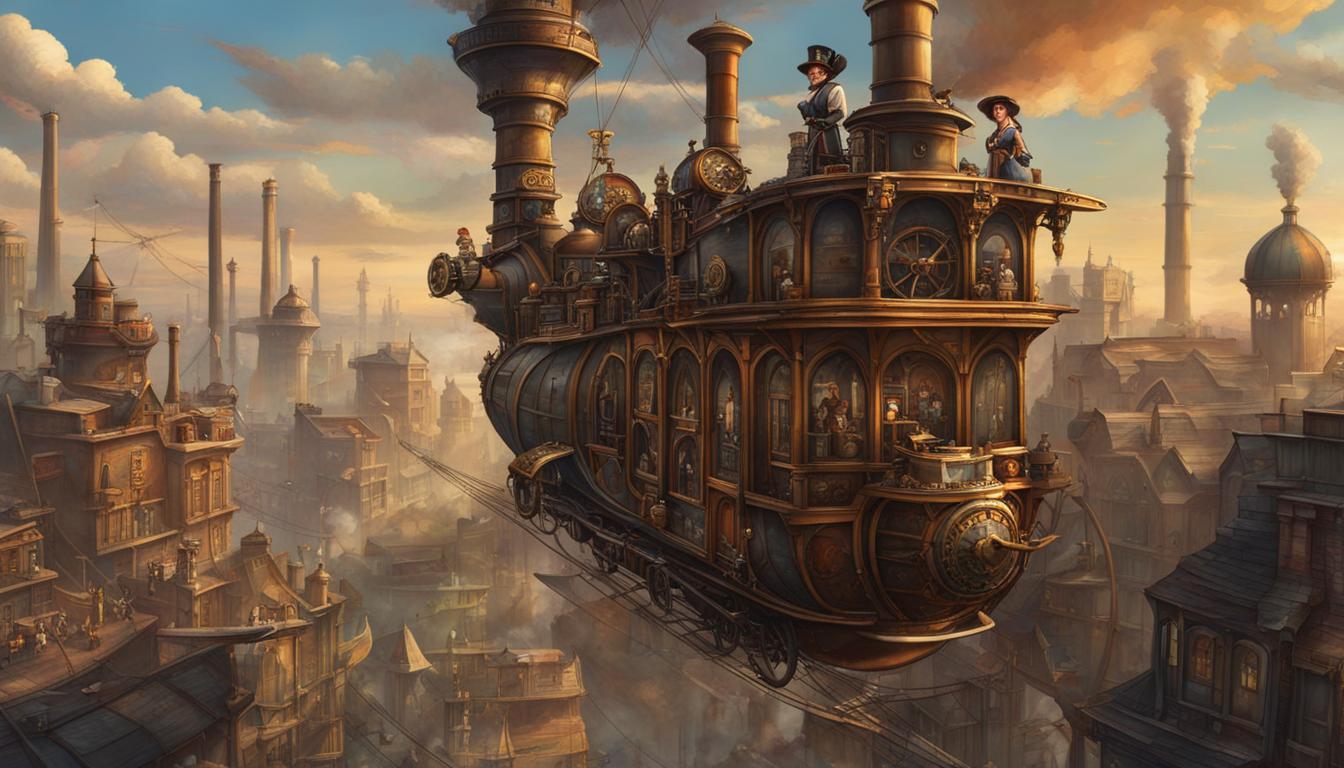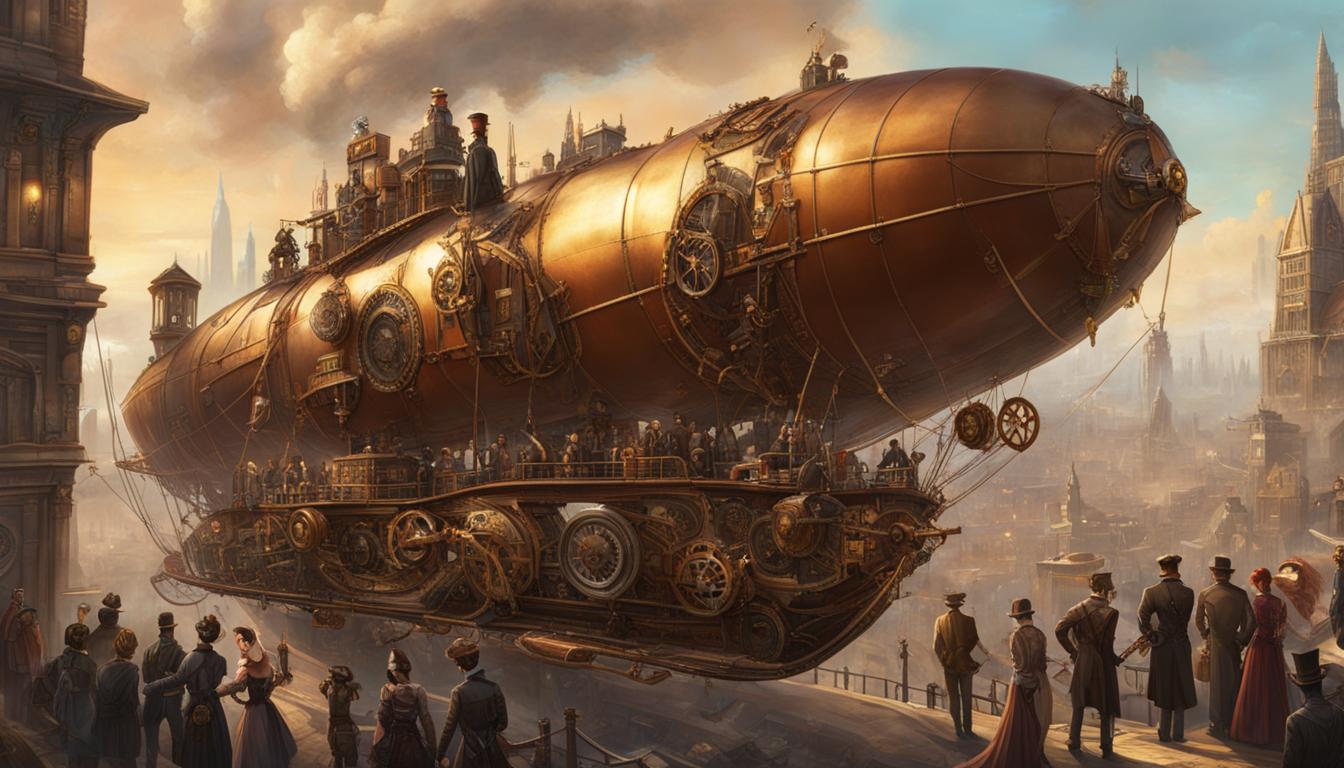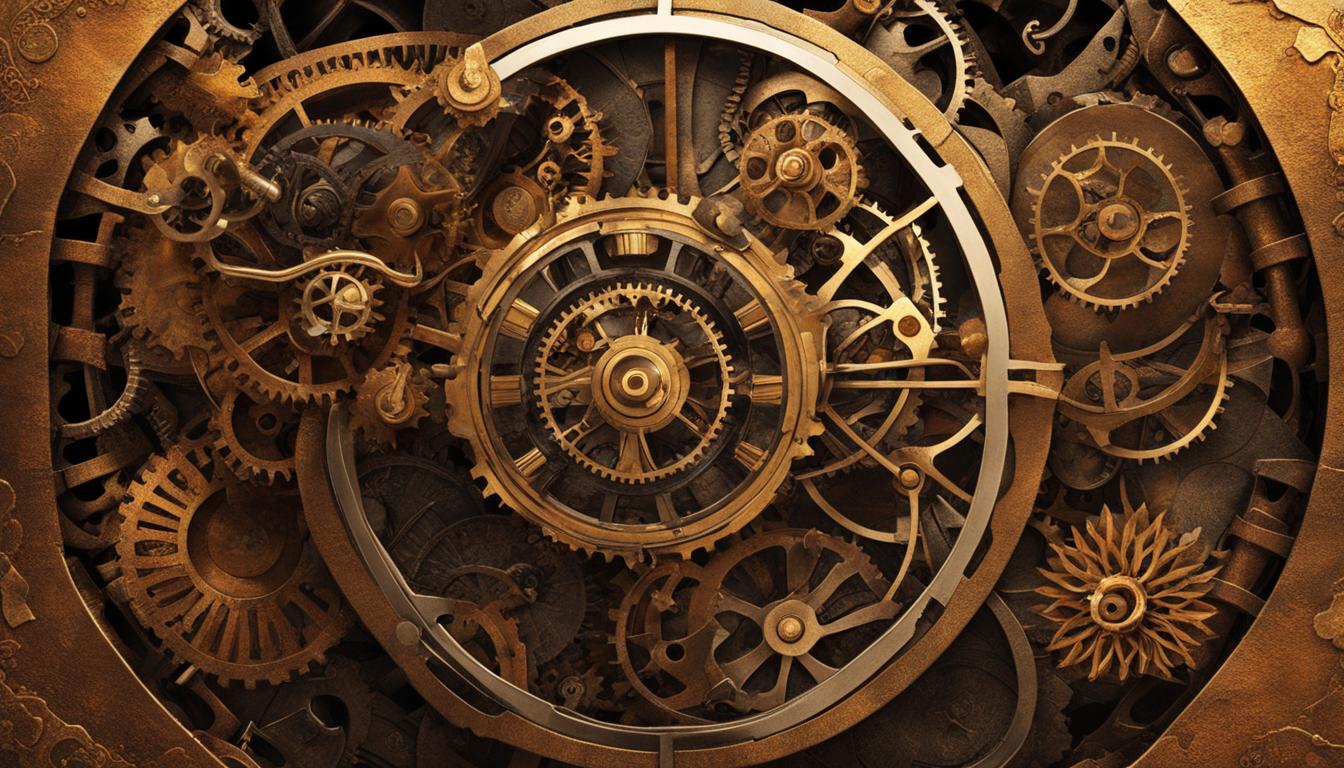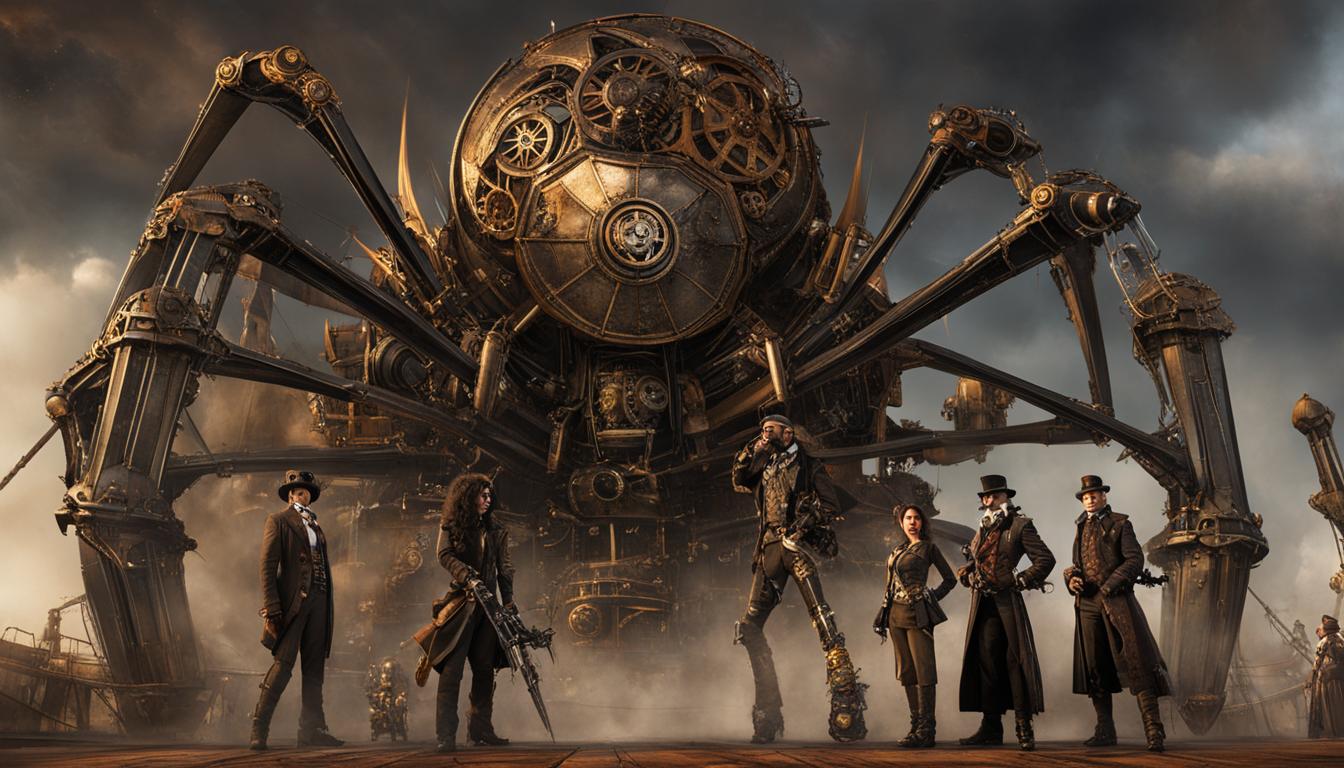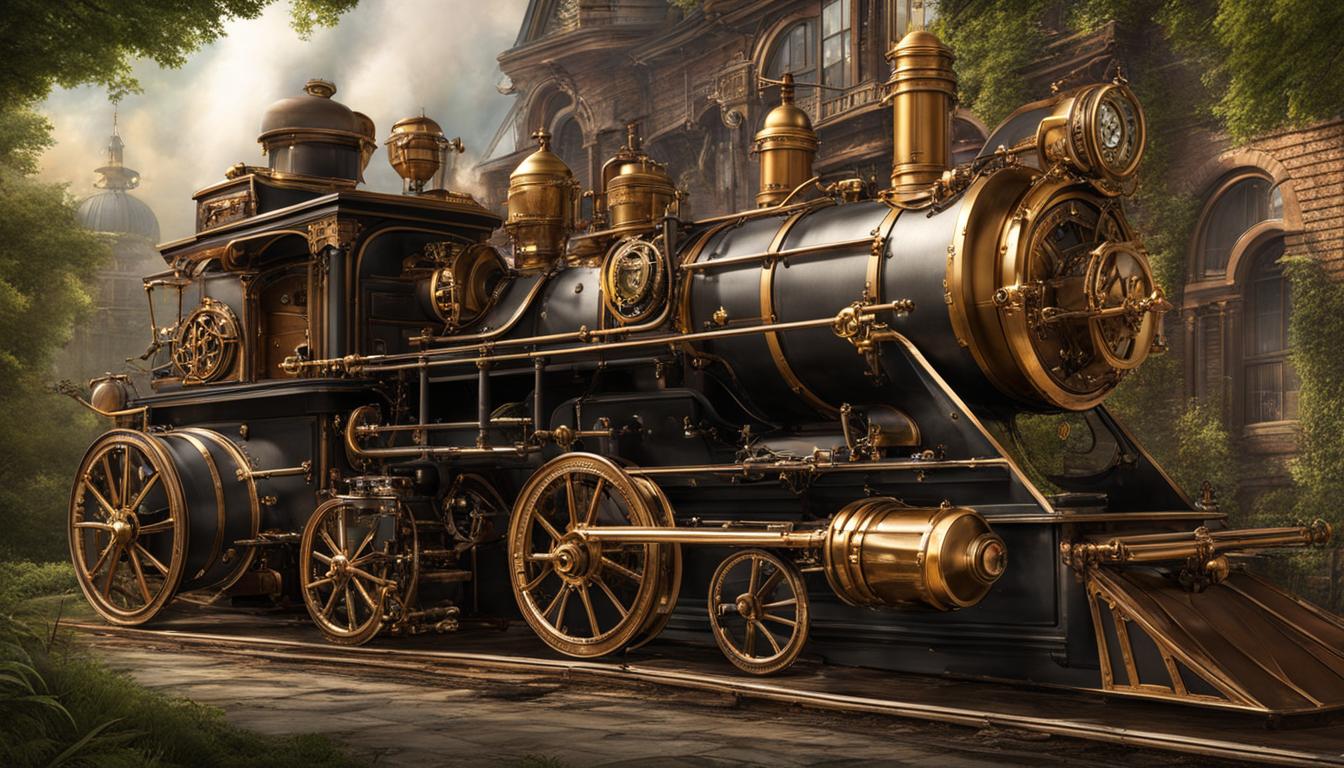Steampunk, a captivating subculture that seamlessly blends Victorian aesthetics with sci-fi elements, offers a mind-bending reimagination of history. It goes beyond a mere homage to the Victorian era and presents an alternate take on past events that is both daring and subversive. From fashion to literature to music and beyond, steampunk challenges our perceptions and invites us to explore fresh perspectives on history.
Key Takeaways:
- Steampunk offers a unique and creative reinterpretation of historical events.
- It combines Victorian aesthetics with sci-fi elements to present an alternate vision of the past.
- Steampunk’s reinterpretation extends to various forms of art, literature, music, and film.
- By challenging dominant narratives, steampunk encourages a more nuanced understanding of history.
- Its impact reaches beyond the subculture, influencing technology and design in significant ways.
The Retrofuturistic Nature of Steampunk
Steampunk is often associated with retrofuturism, a term that refers to the use of a style or aesthetic considered futuristic in an earlier era. In the case of steampunk, this retrofuturism can be seen in the depiction of antiquated technology, such as dirigibles and ornithopters. However, steampunk’s retrofuturism goes beyond technological objects and encompasses a more sophisticated level of reinterpretation.
Steampunk offers innovative takes on historical events, challenging the way we imagine the past and envision the future. Its reinterpretation of history is not limited to technological aspects but also explores the social and cultural spaces of the past. By reimagining the past through a retrofuturistic lens, steampunk opens up new possibilities and fresh perspectives on historical narratives.
Table: Steampunk’s Fresh Perspectives on History
| Aspect | Description |
|---|---|
| Technology | Steampunk showcases antiquated machinery and inventions, reimagining what technology could have looked like in the past. |
| Society | Steampunk explores alternative social structures and power dynamics, challenging traditional notions of class and gender. |
| Culture | Steampunk incorporates elements from literature, art, and music, offering a unique blend of past and future cultural influences. |
| Politics | Steampunk examines political systems and ideologies of the past, providing a platform for critical discussions on political issues. |
“Steampunk’s reinterpretation of history is a captivating blend of nostalgia and imagination, offering a fresh and exciting perspective on the past that pushes the boundaries of creativity.” – Steampunk enthusiast
Steampunk’s retrofuturistic nature and innovative takes on past events make it a truly unique subculture. By reimagining history, steampunk not only entertains but also invites deeper reflections on the narratives that shape our understanding of the past. With its distinctive blend of Victorian aesthetics and sci-fi elements, steampunk captures the imagination and offers a captivating vision of an alternate history.
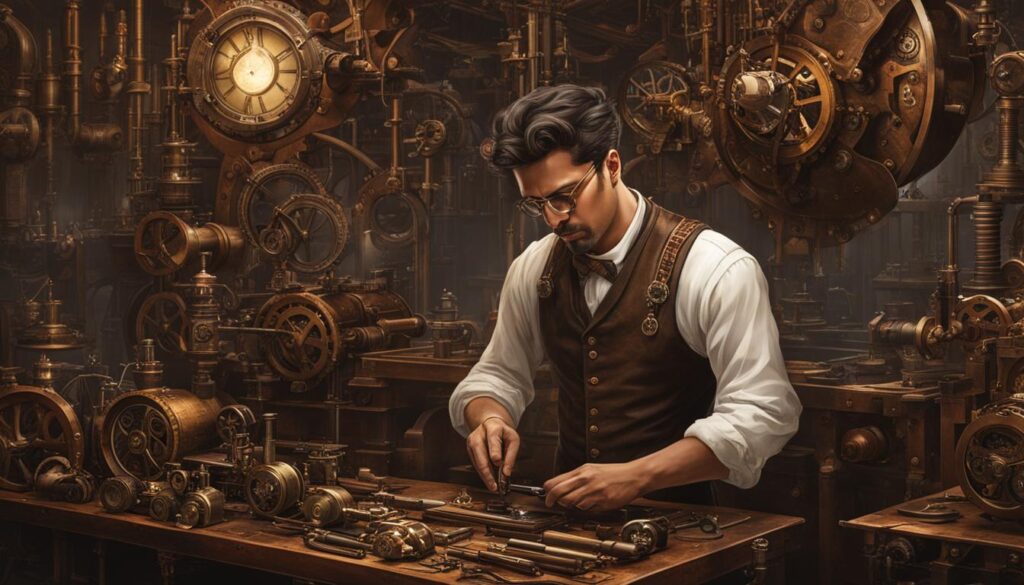
| Table: Steampunk Artisanal Ethos |
|---|
| The artisanal ethos of steampunk emphasizes craftsmanship and attention to detail. |
| Steampunk artists draw inspiration from the Victorian and Edwardian eras to construct something new. |
| Steampunk’s artisanal ethos extends to literature, music, and film. |
| Through the artisanal ethos, steampunk challenges our perceptions of history and offers a reinvention of history narratives. |
The Social and Political Aspects of Steampunk
Steampunk’s reinterpretation of the past goes beyond aesthetics and technology—it delves into social and political themes, challenging our perceptions and sparking important discussions. By twisting historical tales and reimagining the social spaces of the past, steampunk offers a platform for addressing issues such as feminism, colonialism, and imperialism. It invites us to reconsider commonly held narratives and invites a more nuanced understanding of history.
Within the steampunk community, there are fans and activists who engage with the subculture on a deeper level. These individuals take the subversive potential of steampunk to heart, using it as a tool for critical exploration and activism. They tackle complex topics that underlie the aesthetic and embrace the political and social discussions that arise from the reinterpretation of historical narratives.
Steampunk’s influence on historical perceptions can be seen in the conversations and debates it sparks within the community and beyond. By offering fresh perspectives and alternative visions of the past, steampunk challenges the dominant narratives and encourages a more inclusive and diverse understanding of history. It provokes thought and encourages critical thinking, ultimately contributing to a more nuanced and dynamic interpretation of our shared past.
“Steampunk allows us to reimagine history in a way that challenges mainstream perspectives and sparks important conversations about social and political issues.” – Steampunk enthusiast
Steampunk’s Impact on Technology and Design
Steampunk’s reinterpretation of the past extends beyond art and literature, reaching into the realms of technology and design. This subculture’s vision of past events has influenced major tech companies like Intel, who have embraced the steampunk aesthetic in their quest to infuse their devices with humor, humanity, and history. By drawing inspiration from steampunk, these companies are shifting their focus from solely producing faster, smaller, and cheaper products to creating devices that offer more personalized and meaningful interactions for their users.
The influence of steampunk’s innovative takes on past events can be seen in the integration of tactile technology and elements from the past. Rather than relying solely on sleek and modern designs, tech companies are exploring ways to incorporate vintage-inspired elements into their products, such as brass accents and mechanical interfaces. This shift reflects a growing recognition of people’s desire for a deeper connection with technology and a longing for the aesthetics of the past.
Steampunk’s impact on technology and design goes beyond mere aesthetics. It offers valuable insights into the human experience, reminding us that technology should be more than just functional—it should evoke emotion and tell a story. By infusing their devices with steampunk-inspired elements, tech companies are tapping into this desire for a more meaningful connection with technology, creating products that not only perform well but also engage users on a deeper level.
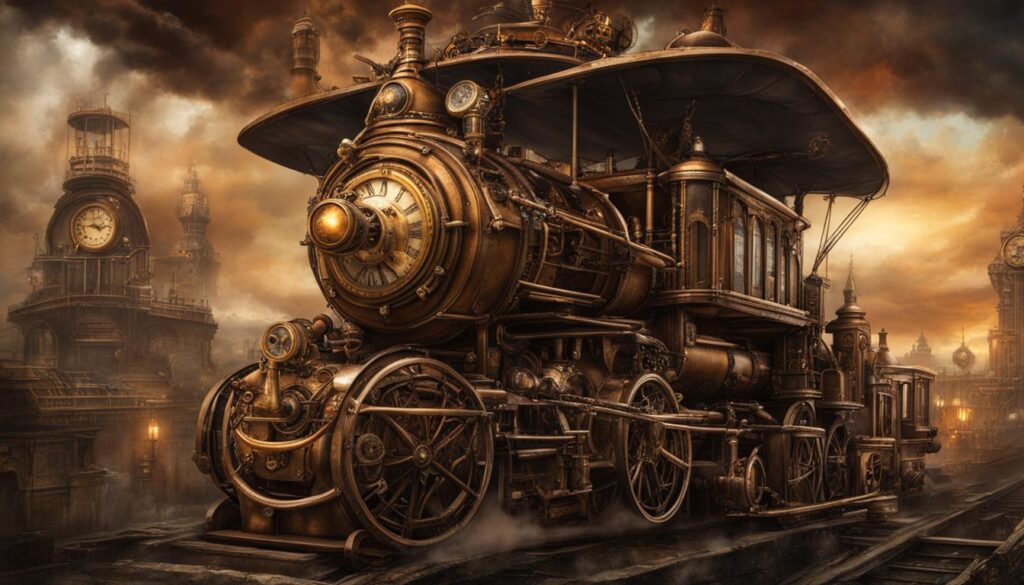
In conclusion, steampunk’s reinterpretation of the past has had a profound impact on technology and design. Its vision of past events has inspired major tech companies to infuse their devices with elements from the steampunk aesthetic, resulting in products that offer a more personalized and meaningful user experience. By embracing a blend of vintage-inspired design and tactile technology, these companies are not only meeting the demands of consumers but also tapping into a longing for a deeper connection with the past. Steampunk’s influence on technology and design showcases the power of creative reinterpretation and offers a fresh perspective on how we interact with and perceive technology in the modern age.
The Multifaceted Nature of Steampunk
Steampunk is a subculture that encompasses various forms of artistic expression, resulting in a multifaceted movement that reimagines the past. From fashion to literature, music to film, steampunk offers a diverse range of mediums through which its reinterpretation of historical narratives can be explored. Each aspect of steampunk culture contributes to a rich tapestry of tales with reimagined history, inviting audiences to engage with alternative perspectives.
One of the key elements of steampunk is its ability to challenge our perceptions of history by presenting a fresh and creative reinterpretation of the past. Steampunk enthusiasts delve into the aesthetics of the Victorian and Edwardian eras, drawing inspiration from speculative traditions to construct a world that blends familiar elements with imaginative twists. This bricolage of historical and fantastical elements creates a reinvention of history narratives that captivates and intrigues.
Whether it’s the fashion choices of steampunk enthusiasts, the narratives found in literature, or the distinctive aesthetics in music and film, steampunk showcases its multifaceted nature throughout all of its expressive forms. The ability to explore historical events and figures through various lenses allows for a dynamic examination of the past. Steampunk subverts conventions, reimagines the social spaces of different time periods, and invites its audience to embark on a journey into a world where history is not fixed, but malleable.
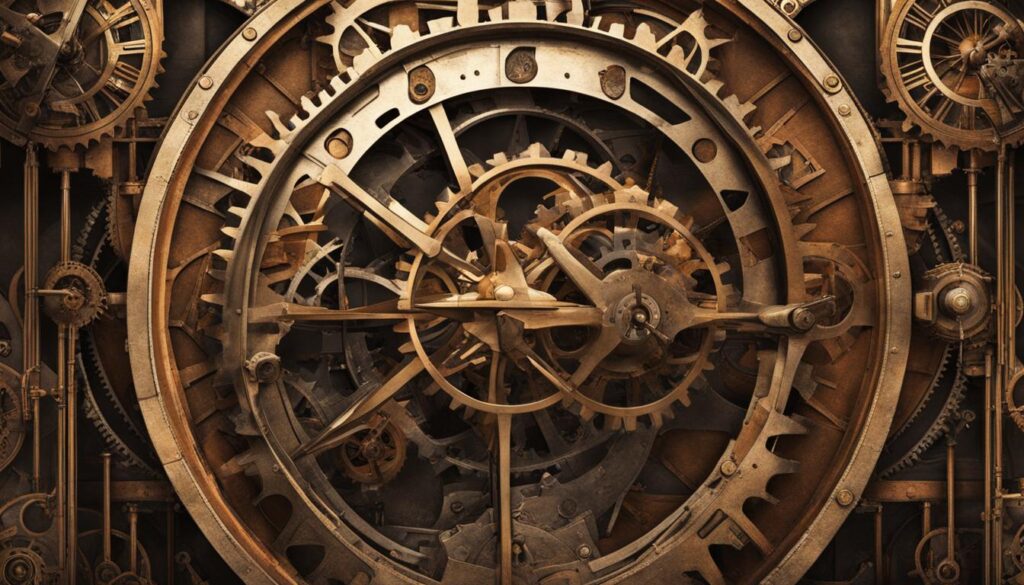
In summary, the multifaceted nature of steampunk is what makes it such a captivating subculture. Through its reinterpretation of the past, it offers a unique perspective on historical events and narratives, challenging traditional views and inviting critical engagement. From fashion to literature, music to film, steampunk weaves tales with reimagined history, capturing the imagination of its enthusiasts and fostering a vibrant and evolving community.
The Fans and Activists of Steampunk
Steampunk’s reinterpretation of historical narratives has attracted a dedicated community of fans and activists who delve deeper into the subculture’s unique reinterpretation of historical events. These individuals go beyond mere appreciation of steampunk’s aesthetics and immerse themselves in the political and social discussions that arise from its creative reinterpretation of the past. By tackling topics such as feminism, colonialism, and class schisms, they bring a critical and activist perspective to the steampunk movement, ensuring that it remains a vibrant and thought-provoking subculture.
Within the steampunk community, fans and activists engage with the subculture in various ways. Some participate in lively online discussions, exchanging ideas and insights about the subversive and alternative visions of history that steampunk offers. Others take their activism offline, organizing events, workshops, and panels that explore steampunk’s potential for raising awareness about important social and political issues.
These individuals recognize that steampunk’s reinterpretation of the past extends beyond mere entertainment value. Through their involvement, they highlight the subculture’s capacity for fostering critical conversations and challenging mainstream historical narratives. Steampunk’s fans and activists ensure that its unique and creative reinterpretation of the past remains a vital force that pushes boundaries and encourages deeper exploration of our collective history.
“Steampunk allows us to reimagine history narratives and stimulate conversations about important social issues. It’s not just about playing dress-up; it’s about challenging the status quo and inviting others to question commonly held perceptions.” – Sarah, Steampunk Enthusiast
The Impact of Steampunk Activism
Steampunk activism goes beyond the subculture itself, influencing wider conversations about history, politics, and societal norms. By reimagining historical narratives and inviting critical discussions, steampunk offers a fresh and creative space for examining the complexities of the past. Through their engagement, fans and activists contribute to a more nuanced understanding of history, shedding light on marginalized voices and challenging dominant narratives.
Furthermore, steampunk’s unique reinterpretation of historical events has the potential to inspire activism outside of the subculture. By showcasing alternative perspectives on issues such as feminism, colonialism, and class struggles, steampunk provides a platform for individuals to rethink traditional power structures and envision a more inclusive and equitable future.
The Future of Steampunk Activism
As steampunk continues to evolve and inspire, there is a growing recognition of its potential as a catalyst for change. Fans and activists are pushing the boundaries of the subculture, exploring new ways to engage with social and political issues while maintaining steampunk’s core principles of creativity, innovation, and reinterpretation of the past.
With ongoing discussions, events, and collaborations, it is clear that steampunk activism is here to stay. As fans and activists continue to challenge traditional historical narratives and shape new conversations, steampunk’s impact on society and culture will undoubtedly continue to grow, offering a lasting and significant contribution to our understanding of the past.
Conclusion
Steampunk’s reinterpretation of the past is a unique and captivating journey into history. By combining Victorian aesthetics with sci-fi elements, steampunk offers a fresh and engaging perspective on historical events. It goes beyond mere homage and reinvents history narratives with a subversive twist, challenging our perceptions and inviting us to explore alternative perspectives.
With its emphasis on craftsmanship and attention to detail, steampunk embraces an artisanal ethos that adds depth and creativity to its reinterpretation of the past. From fashion to literature to technology, steampunk’s impact extends beyond the subculture itself. Major tech companies have taken cues from steampunk in their quest for more personalized and meaningful interactions with their devices, infusing their products with humor, humanity, and a touch of history.
Steampunk is a multifaceted subculture that thrives on the creativity and passion of its diverse community. Its influence goes beyond aesthetics and technology, delving into social and political themes. Steampunk sparks conversations and debates, challenging commonly held perceptions and highlighting the critical and activist perspectives of its fans and activists. By reimagining history narratives, steampunk pushes the boundaries of creativity and offers a vibrant and dynamic subculture that is as intriguing as it is inspiring.
FAQ
What is steampunk?
Steampunk is a subculture that combines Victorian aesthetics with sci-fi elements, offering a unique and creative reinterpretation of historical events.
How does steampunk reinterpret the past?
Steampunk reimagines history with a subversive twist, going beyond simple homage to the Victorian era and offering fresh perspectives on historical events.
What is retrofuturism?
Retrofuturism refers to the use of a style or aesthetic considered futuristic in an earlier era. In the case of steampunk, it involves depicting antiquated technology and reinterpreting historical narratives.
How does steampunk embrace craftsmanship?
Steampunk’s artisanal ethos emphasizes careful attention to detail, allowing for a creative reinterpretation of the past through fashion, literature, music, and film.
Does steampunk explore social and political themes?
Yes, steampunk’s reinterpretation of the past opens up discussions on feminism, gender, colonialism, postcolonialism, imperialism, and other important issues.
How does steampunk influence technology and design?
Steampunk’s alternative vision of the future and focus on tactile technology inspires tech companies to infuse their devices with humor, humanity, and elements from the past.
How does steampunk manifest in different forms of artistic expression?
Steampunk’s reinterpretation of history can be seen in fashion, literature, music, and film, offering rich and diverse exploration of historical narratives.
Are there fans and activists within the steampunk community?
Yes, some steampunks engage with the subculture on a deeper level, tackling critical social and political issues and bringing activist perspectives to the movement.

